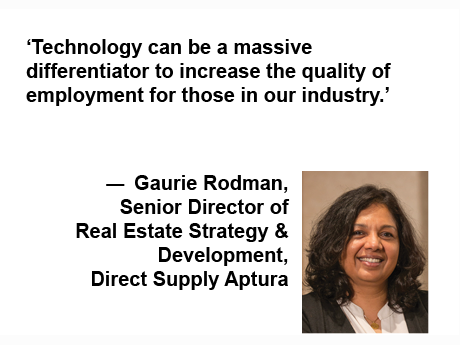Senior living communities, often strained by labor shortages, can benefit from design and technology strategies built to streamline how employees spend their time. While the focus in any construction, design or renovation project must be on resident needs first, an in-depth planning approach can benefit the community as a whole — especially staff.
Technologies — including fall detection and prevention, real-time location systems (RTLSs) and strong Wi-Fi — are at the heart of making sure staff can focus on residents. Good technology design is an essential part of making sure a space supports smooth and efficient workflows.
What works well for seniors is often what works well for staff. This includes well-designed areas that allow staff to take on additional responsibilities and maximize employee time by keeping residents safe and entertained while giving clinicians the tools they need most in the event of emergencies.
Technology with Strong Wi-Fi as the Foundation
The implementation of time-saving technology (like RTLSs, fall prevention/detection technology, digital ordering and even robots to perform repetitive tasks) frees up staff time to focus their attention on residents.

Justin Smith,
Direct Supply
“Strong Wi-Fi and overall data infrastructure within a building will be requirements moving forward. Whether technology solutions are implemented to conserve employee time or help provide better outcomes, data infrastructure within the building is the kind of foundational element essential for these efficient systems to work as needed,” explains Justin Smith, innovation and technology manager at Direct Supply.
Gaurie Rodman, senior director of real estate strategy & development at Direct Supply Aptura, puts the situation bluntly: “Before you even start looking at new technologies, you better make sure you have the infrastructure to support it.”
Strong Wi-Fi in senior living (and planning for heavy Wi-Fi use from the beginning), means that essential Wi-Fi (for business-critical or medical systems) is never competing with recreational uses (like streaming TV shows or making video calls). Plus, building with Wi-Fi in mind from the beginning ensures residents, staff and visitors stay connected.
Fall detection technology (like SafelyYou) helps maximize employee efficiency by preventing falls in the first place. With SafelyYou, a community can offer peace of mind to seniors and their loved ones, detect and prevent falls with results-driven AI and give staff insight to fall-related incidents that has otherwise not existed. Senior living communities using SafeyYou have seen up to an 80 percent reduction in fall-related ER visits.* Staff can avoid dealing with the aftermath of fall incidents with SafelyYou fall detection.
Rodman explains that “in terms of staffing, we’re optimizing clinicians. Because machine vision is capturing the event, it has the artificial intelligence to note when a fall has occurred. The technology only keeps that snippet of information related to a fall. That video is immediately sent to a clinician pool (putting the expertise into one point team) and giving them the information needed to make a quick decision.”
There are proven efficiency-related results visible through RTLSs also. CenTrak is built to improve operational efficiency and cost of care via a single platform that promotes security and emergency responses in the event of residents wandering.
“The idea behind an RTLS is to optimize your workforce,” elaborates Smith. “It can be used to identify where caregivers or equipment systems are within the building, reducing time spent walking around searching. We’ve heard comments from customers and clinicians saying they spend 40 percent of their time providing care and 60 percent of their time looking for people or equipment.” With a holistic system like CenTrak in senior housing, that wasted time can be cut drastically.
Improving efficiency can mean higher rates of satisfaction and retention for staff. “Technology can be a massive differentiator to increase the quality of employment for those in our industry,” says Rodman. When the tech is designed properly in a community, employees can focus on the kind of positive personal interactions that led them to choose working with seniors in the first place.
Design to Promote Independence and Efficiency

Rebecca Keller, Direct Supply Aptura
Rebecca Keller, senior lead interior designer at Direct Supply Aptura, describes how senior living design is shifting away from a limited vision of design toward design that helps seniors help themselves and interact with staff. The strict focus on ADA guidelines — only considering hard limits like wheelchair approaches, counter heights and hallways requirements — has given way to what Keller refers to as “universal design,” which includes ADA requirements while elevating the specific needs of higher acuity residents.
“Universal design” focuses on making life easier. Thresholds need to be seamless to navigate, surfaces should be high contrast (to highlight visually where edges, counters, walls and more begin and end) and communities should incorporate visual and tactile cues for wayfinding.
Promoting resident independence frees up staff time. Keller also explains that much of Direct Supply Aptura’s design structure is “based around the residents’ activities and their needs, as well as a community’s staffing needs.” Keller describes conveniences like offices that open onto reception areas or bistros — allowing staff to concentrate tasks into a single area. This approach promotes staff visibility and proximity, while allowing staff to take on multiple roles at a time in these multi-layered spaces.
Some communities are also offering amenities within the building to their workers that improve staff quality of life. Package rooms, refrigerators/freezers and clinical services that make life easier for residents can often be extended as an employee benefit as well.
Finally, blending design and tech is easier for Direct Supply Aptura because “we do work hand in hand with our technology designers” to make the practical (routers, cables, outlets, walls, chosen building materials, etc.) into something aesthetically pleasing.
Rodman simplifies the connection between design and tech. “I think that any investment made in design to promote Wi-Fi speaks to the quality of our buildings,” says Rodman. “If I have a building that is optimally supported for technology (Wi-Fi optimized and corded connections beautifully integrated for everyday life), I can drive better net operating income and my real estate is more valuable” because it works better for both residents and staff.
The Future of Staffing and Community
Rodman explains the exciting possibilities of leveraging local partnerships by integrating seniors housing into larger communities. Senior living facilities can elevate staff and socialization if they build on Main Street and incorporate spaces that can also serve the community — think coffee shops, bistros, clinical spaces and other needed retail concepts, all in a senior living space staffed by outside companies. “In this vision, we’re optimizing the staff, the people and the real estate in order to meet the needs of both of the outside community as well as the inside community.”
Blending technology and interior design helps promote streamlined workflows that benefit staff and residents. There are opportunities to apply this thinking no matter your scope or budget.
— By Sarah Daniels. This sponsored content was written in conjunction with Direct Supply.
*Van Doorn C, Gruber-Baldini AL, Zimmerman S, et al; Epidemiology of Dementia in Nursing Homes Research Group. Dementia as a risk factor for falls and fall injuries among nursing home residents. J Am Geriatr Soc. 2003;51(9):1213-1218.

